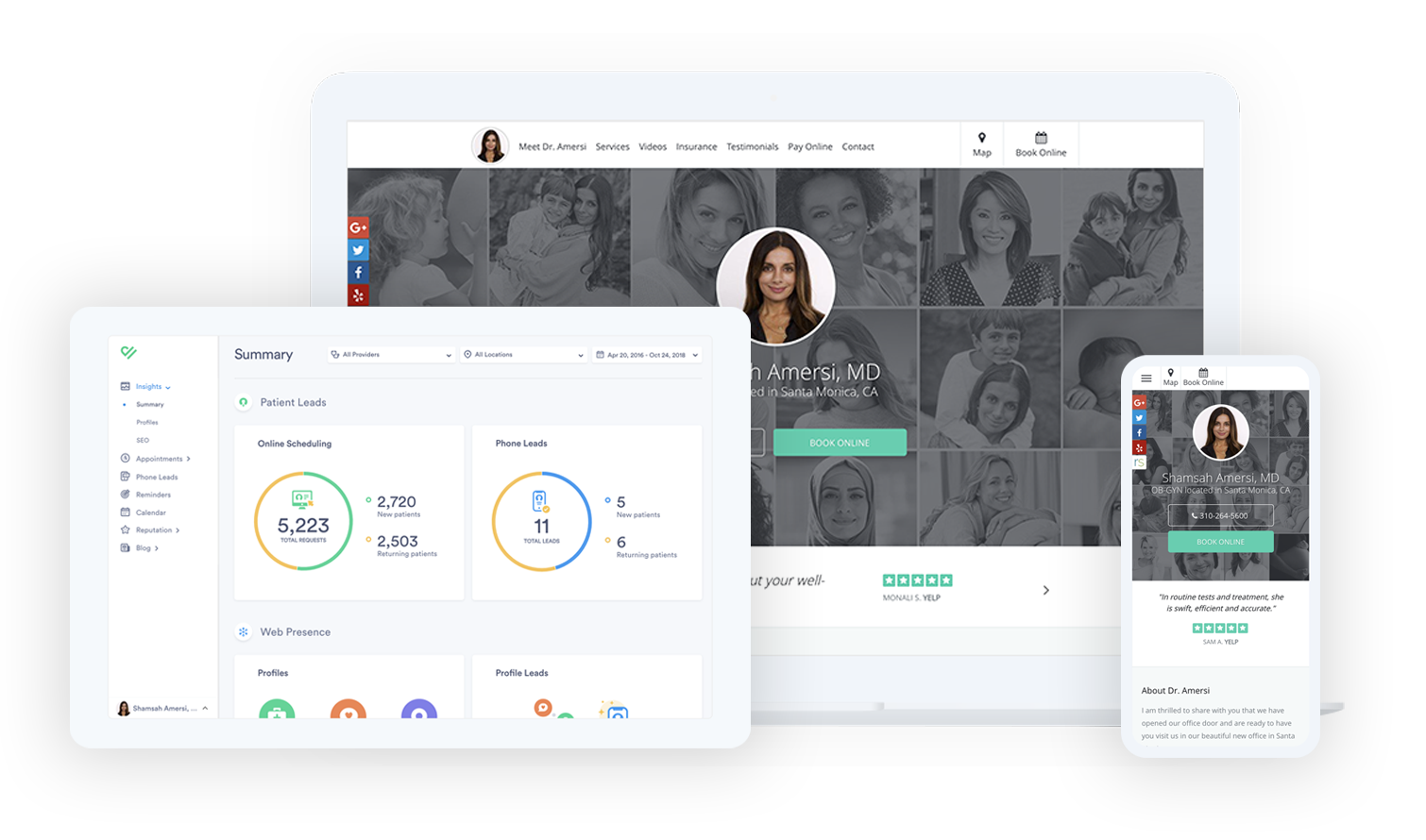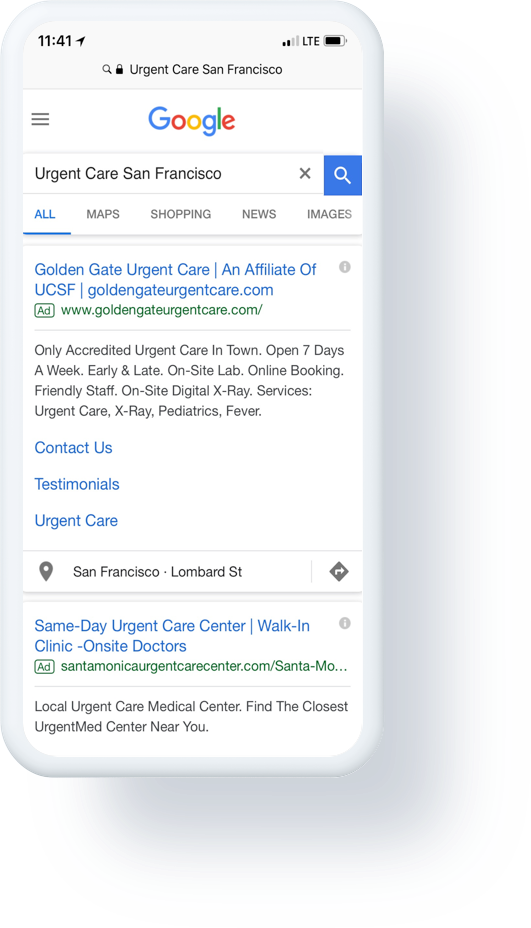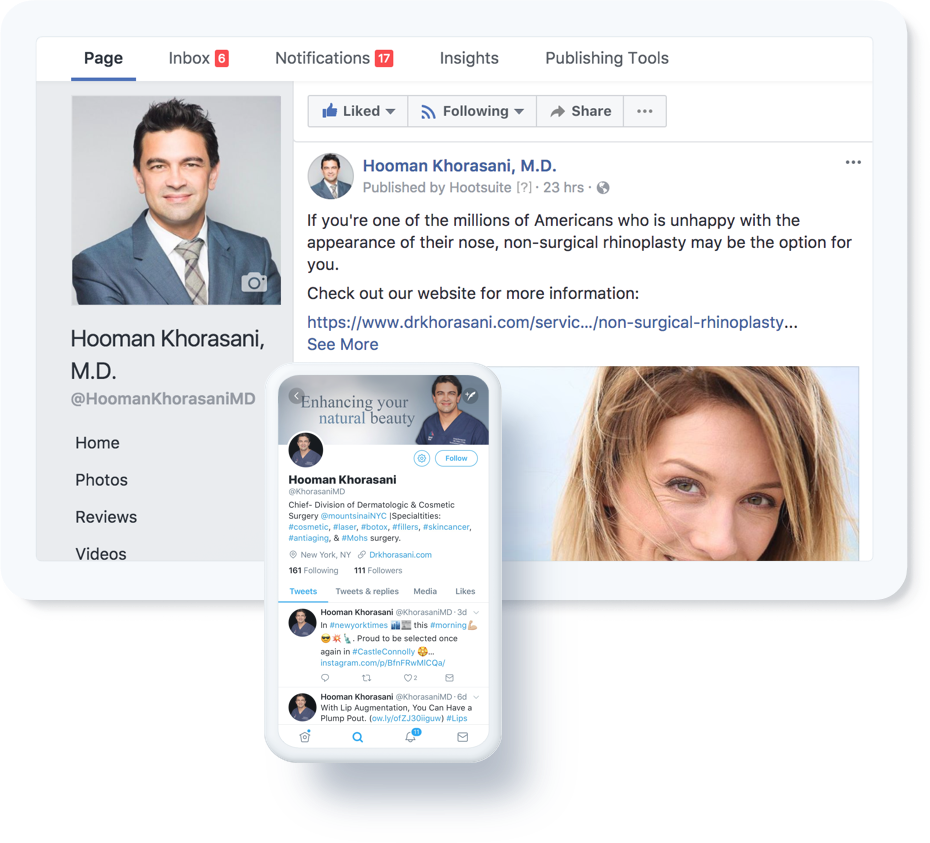Medical and healthcare advertising in the digital age
Healthcare advertising in the digital age requires a digital approach. Although many traditional offline tactics are still viable, a well-rounded, effective medical advertising strategy requires an online multi-channel approach with precise targeting.
Happy Providers
Powered by PatientPop
With a focus on continuous innovation, PatientPop offers the healthcare industry's first all-in-one practice growth platform specifically designed for healthcare providers.

Paragon Eye Associates

Alan B. Patterson, M.D.

Pandit Foot & Ankle
Compare your practice
See how your entire online performance compares with other practices in your local area.
PatientPop compares and analyzes your practice growth and finds opportunities to help you improve.

A shift in medical and healthcare advertising
Healthcare marketing and advertising no longer consist of billboards and magazine ads alone.. The digital approach to healthcare advertising utilizes precise targeting and tracking to ensure paid ads are reaching the right audience for maximum return on investment (ROI) and conversion.
Modern advertising tools for medical and healthcare
Digital advertising in the medical and healthcare sectors is made up of multiple key parts: Google ads and pay-per-click (PPC) campaigns, social ads, email campaigns, and even mobile.


The perks of digital advertising
Digital advertising goes beyond traditional advertising, allowing practices and brands to reach the right people through advanced targeting and tracking. This means advertisers see a better ROI, a higher success rate with patients, and a better experience for the user and brand.
Medical and healthcare advertising trends
The tools being used in medical and healthcare advertising won’t be changing dramatically in the near future, but the ways in which ads are presented will. Ads will begin to look less like ads and more like natural, relatable content for target audiences.

Medical and healthcare advertising in the digital age
Much like modern marketing, medical and healthcare advertising in today’s landscape requires a research-backed, digital approach. In place of traditional commercials and billboards are paid search campaigns, social media ads, and website promotions, each targeting a specific audience.

A shift in medical and healthcare advertising
Before social media and online platforms took off, medical and healthcare advertising were more straightforward in their approach, although less effective than today’s advertising. Billboards, magazine ads, TV campaigns and direct mail were the usual tools of an advertiser.
Today, advertising requires a largely digital approach. Google Ads and paid search often have an ROI of $2 for every $1 spent, while social ads give practices the chance to reach those on Facebook or other platforms. With a record number of users on smartphones and connected via the internet, digital advertising isn’t a convenience, it’s necessary. The healthcare advertising rules have changed, and you need to follow them to stay afloat.
More about medical and healthcare advertising:
Outdated Healthcare Practice Marketing Ideas Providers Should Stop

Modern advertising tools for medical and healthcare
It’s not uncommon for potential patients to take their searches to Google before contacting a doctor. In fact, one in 20 searches on Google are healthcare related. Digital advertising gives practices the opportunity to capture this audience using a number of tools at their disposal.
More about advertising tools for medical and healthcare:
How the Internet Changed the Way New Patients Find a Physician
Paid search or Google Ads (formerly AdWords)
A paid search campaign, usually handled using Google Ads, is one of the most popular forms of digital advertising. In a paid search campaign, a company or practice can bid on select keywords they would like to capture. They then set a budget, which will last varying amounts of time as the cost-per-click shifts. Although there are some restrictions on the medical and healthcare industries, Google ads can still be very effective.
Targeting the right terms gives practices the opportunity to capture audiences searching for those terms. In this case, a dental practice could bid on words pertaining to various conditions. Using advanced targeting, Google ads would be shown to those searching, increasing your chances of that person seeing your ad and discovering your practice.
Google ads can also take advantage of retargeting, allowing various versions of an ad to be shown to a specific user as they frequent different websites. This can result in your ads targeting users at different stages of the funnel, and increase the chances of them clicking.
It’s important to keep in mind that, for privacy reasons, Google does have restrictions pertaining to remarketing certain medical products and services.
More on medical advertising:
Online advertising for doctors - the Practice Growth Podcast
Marketing your private practice with paid advertising
Paid Search Marketing: What It Is & How It Can Get You to the Top of Search
Paid Social Ads
Similar to paid search, paid social ads are targeted ads that run for a specific period on different social media platforms. Social ads have several strengths that differentiate them from search ads:
- They allow you to target your audience in a more passive way
- They offer network-based targeting that goes beyond traditional targeting
- They’re often more affordable than paid search ads
- Their click-through rate is much higher than normal display ads
- Social ads are generally easier to use than paid search campaigns
With nearly 1.5 billion people on Facebook every day, social ads are a great way to ensure your ads are getting in front of people on the go. Not only this, social ads can be great for testing different demographics, as they’re more affordable than PPC in many cases.
Keep up-to-date with Facebook’s ad guidelines and restrictions here.
More on paid medical advertising:
Paid Search Marketing: What It Is & How It Can Get You to the Top of Search
Facebook advertising for healthcare practices: everything you need to know
Attract more patients online

The perks of digital advertising
Before the digital revolution reached advertising, ads were very much a “fire and forget” approach. With digital advertising, analytics are readily available, allowing you to hone your targeting and reach the right audience. This is only scratching the surface of digital advertising’s many strengths.
- Social ads can go viral: Unlike a billboard or magazine clipping, a digital ad has the potential to go viral and be shared across social media, giving you free exposure.
- Insights and analytics: Tracking analytics on physical ads is incredibly difficult, while digital ads have numerous analytics and reporting features built in.
- Advanced targeting: Rather than doing extensive research through costly test groups, you can easily experiment with targeting using digital ads. Not only this, retargeting lets you make up for missed opportunities by showing various versions of an ad across numerous sites.
- They’re adaptable: If you realize an ad isn’t performing well enough or if the market quickly shifts, digital advertising is far easier and faster to change to meet the demands of your audience. It’s also easier to completely halt an ad if it’s not performing or resonating.
More on digital advertising:
How to Tell Whether Your Practice Marketing Is Working
ROI Runaround: How Physicians Can Spot Evasive Marketing Vendors

Medical and healthcare advertising trends
Unlike the digital marketing landscape, where trends are shifting every moment, the digital advertising landscape isn’t changing as drastically right now. Even still, there are a few trends emerging that are worth investing in as soon as possible.
Native ads will continue growing
Native advertising is the practice of integrating ads that match their surrounding platform. These are often featured on social media — primarily Instagram and Facebook — as they can easily blend in with the look of the platform and look like a native post.
Native ads often allow users to interact with the ad, giving them the ability to comment and respond. This makes them a great way to both advertise to your potential audience, and also engage with them to spread brand awareness and build trust.
The rise of the omni-channel experience
The days of an ad experience ending with a billboard or single viewing of a popup ad are over. In order to stay engaged and stand out, brands need to deliver an omni-channel ad experience that seamlessly bridges the gap between physical and digital ads, and their actual practice.
Landing pages play a bigger role
Landing pages are crucial in digital marketing campaigns, but until recently have played a smaller role in advertising.
Experts predict that landing pages should and will play a larger role in digital advertising campaigns, with landing pages linked to ads serving to guide people through different stages of the funnel.
These landing pages can inform interested parties by offering more information than an ad, and also allow for users to put in their email address in exchange for white papers, guides, or other materials made by your practice.
Healthcare advertising companies
If an in-house healthcare advertising specialist is out of the question, collaborating with a healthcare advertising agency could be your best bet. In fact, there are a number of perks that come from working with an external healthcare advertising company:
- A focus on creative healthcare advertising: If you have an internal advertising specialist, great. If not, you’re looking at a lengthy period of hunting, interviewing, hiring, and training. Contracting with a reputable third-party agency allows you to get to work right away with specialized advertising consultants. Agencies that specialize in medical advertising are up-to-date on the latest advertising tactics, and often have creative partners that can take an innovative healthcare advertising campaign to the next level.
- They know the rules: There are a number of regulations when it comes to advertising in the healthcare industry. Advertising agencies are often abreast of the latest in healthcare regulations, meaning they can get straight to work on the ads and not stress about the small print. Not only this, typical ad agencies will stay on top of the healthcare advertising trends far better than the layman.
- You can vet them: Sure, when someone applies to be your ad expert, you can check their resume and portfolio. Still, things can be easier when you’re vetting an agency. Agencies often have extensive online portfolios, testimonials, and evidence they know their trade. Search for top healthcare advertising agencies in your area, and have a look at their portfolios to get a feel for what types of healthcare ads and campaigns they’ve run in the past. You don’t need an agency that’s won any healthcare advertising awards; you simply need one that matches your needs.
Before you take the plunge and lock in a costly ad agency, consider looking at the many ways PatientPop can take your practice straight into the digital age.
More on advertising trends:
2022 healthcare marketing trends for independent practices
How to engage on social media with HIPAA in mind
A Practice Growth Specialist will contact you shortly.
Compare your practice
Enter your contact information
We'll send your personalized results to your email.
Practice competitive scanner
Compare your practice
Instantly see how you compare to other practices in your local area and specialty.